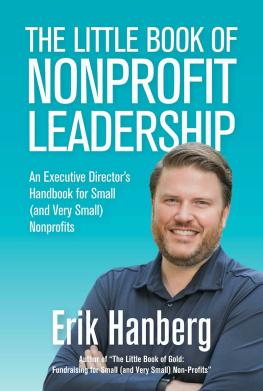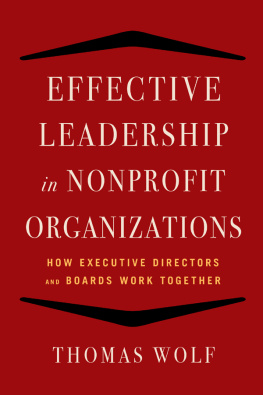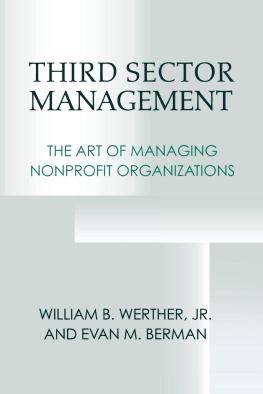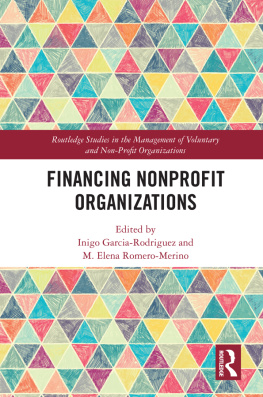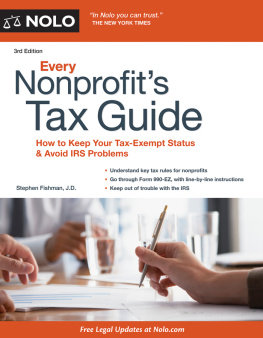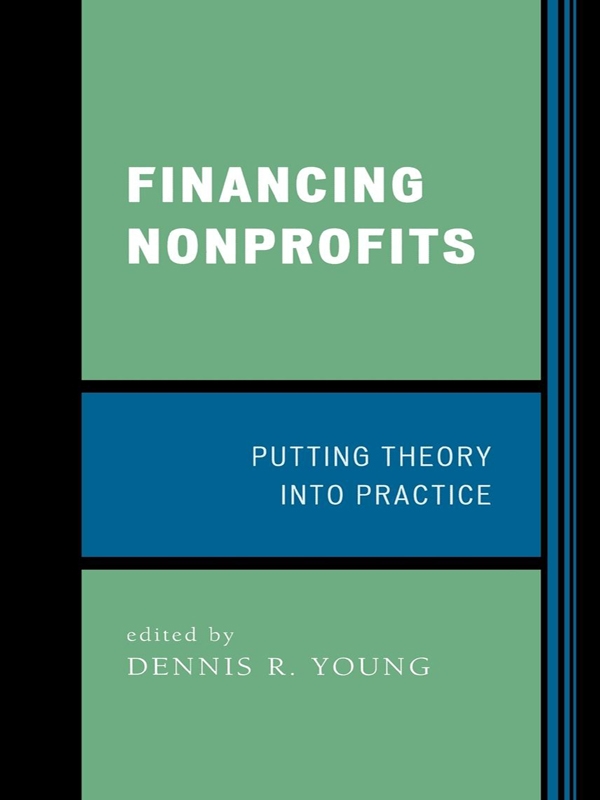References
Albert, Stuart, and David A. Whetten. Organizational Identity. In Research in Organizational Behavior, Vol. 7, edited by L. L. Cummings and B. M. Staw. Greenwich, CT: JAI Press, 1985.
Altman, Edward. Ratios Discriminant Analysis, and the Prediction of Corporate Bankruptcy. Journal of Finance 23, no. 4 (1968): 589609.
American Institute of Certified Public Accountants. AICPA Audit and Accounting Guide: Not-for-Profit Organizations. New York: AICPA,1996.
American Law Institute Restatement of the Law, Third: Trusts. St. Paul, MN: American Law Institute, 2003.
American Society of Association Executives. Policies and Procedures in Association Management. Washington, DC: ASAE, 1996.
. Operating Ratio Report. 12th ed. Washington, DC: ASAE, 2003.
Andreoni, James. Giving with Impure Altruism: Applications to Charity and Ricardian Equivalence. Journal of Political Economy 97 (1989): 1447-58.
. Impure Altruism and Donations to Public Goods: A Theory of Warm-Glow Giving. Economic Journal 100 (1990): 467-77.
Andreoni, James, and A. Abigail Payne. Do Government Grants to Private Charities Crowd Out Giving or Fundraising? American Economic Review 93 (2003): 792-812.
Arenson, Karen W. Bankruptcy Case May Cost Charities Heavily. New York Times, May 16,1995, late edition-final, sec. A, p. 14.
Arrow, Kenneth. Social Choice and Individual Values. New York: Wiley, 1951.
. Gifts and Exchanges. Philosophy and Public Affairs 1 (1974): 343-62.
Arsenault, Jane. Forging Nonprofit Alliances: A Comprehensive Guide to Enhancing Your Mission Through Joint Ventures and Partnerships, Management Service Organizations, Parent Corporations and Mergers. San Francisco: Jossey Bass, 1998.
Atkinson, Anthony, Robert Kaplan, and S. Mark Young. Management Accounting, 4th ed. Upper Saddle River, NJ: Pearson Prentice Hall, 2004.
Austin, James E. The Collaboration Challenge: How Nonprofits and Businesses Succeed Through Strategic Alliances. San Francisco: Jossey Bass, 2000.
Bailey, Elizabeth E., and Ann F. Friedlander. Market Structure and Multiproduct Industries. Journal of Economic Literature 20, no. 3 (1982): 102448.
Baruffi, Lisa J. Take Notice: 501(c) 6 Compliance Issues. www.asaenet.org > (20 May 2005).
Bass, Gary, John Irons, and Ellen Taylor. The Big Squeeze: Impacts of Federal Budget and Tax Policy. Responsive Philanthropy (Spring 2004): 611.
Beaver, William. Financial Ratios as Predictors of Failure. Journal of Accounting Research. Supplement 4, no. 3 (1966): 71-111.
Becker, Gary. A Theory of Social Interactions. Journal of Political Economy 82 (1974): 1063-93.
Beil, Richard 0., and David N. Laband. The American Economic Association Dues Structure. Journal of Economic Perspectives 10 (1996): 179-186.
Ben-Ner, Avner. Obtaining Resources Using Barter Trade: Benefits and Drawbacks. Pp. 278-98 in Nonprofit Organizations in a Mixed Economy: Understanding New Roles, Issues and Trends, edited by David C. Hammack and Dennis R. Young. San Francisco: Jossey Bass (1993).
. The Shifting Boundaries of the Mixed Economy and the Future of the Nonprofit Sector. Annals of Public and Cooperative Economics 73, no. 1 (2002): 5-40.
Ben-Ner, Avner, and Benedetto Gui, eds. The Nonprofit Sector in the Mixed Economy. Ann Arbor: University of Michigan Press, 1993.
Bergman, Jed I. Managing Change in the Nonprofit Sector. San Francisco: Jossey Bass, 1996.
Bergquist, William, Julie Betwee, and David Meuel. Building Strategic Relationships: How to Extend Your Organizations Reach Through Partnerships, Alliances and Joint Ventures. San Francisco: Jossey Bass, 1995.
Berresford, Susan V. Collaboration: Models, Benefits, and Tensions. Pp. 137-46 in An Agile Servant: Community Leadership by Community Foundations, edited by Richard Magat. Washington, D.C.: Council on Foundations, 1989.
Bielefeld, Wolfgang. Nonprofit Funding Environment Relations. Vol-untas 3, no. 1 (1992): 48-70.
Blattberg, Robert C., and Cynthia J. Broderick. Marketing of Art Museums. Pp. 327-46 in The Economics of Art Museums, edited by Martin Feldstein. Chicago: University of Chicago Press, 1991.
Blum, Walter J., and Harry Kalven Jr. The Uneasy Case for Progressive Taxation. Chicago: University of Chicago Press, 1953.
Bolman, Lee, and Terrance Deal. Reframing Organizations: Artistry, Choice, and Leadership. San Francisco: Jossey Bass, 1997, 99-262.
Boraas, Stephanie. Volunteerism in the United States. Monthly Labor Review (August 2003).
Boris, Elizabeth T. The Nonprofit Sector in the 1990s. In Philanthropy and the Nonprofit Sector in a Changing America, edited by Charles Clotfelter and Thomas Ehrlich. Bloomington: Indiana University Press, 1987.
. Organizations in a Democracy: Varied Roles and Responsibilities. Pp. 133 in Nonprofits and Government: Collaboration and Conflict, edited by Elizabeth T. Boris and C. Eugene Steuerle. Washington, D.C.: Urban Institute Press, 1999.
. Scope and Dimensions of the Nonprofit Sector. Pp. 6688 in Nonprofit Sector: A Research Handbook, 2nd ed., edited by Richard Steinberg and Walter W. Powell. New Haven, CT: Yale University Press, 2006.
Boris, Elizabeth T., and C. Eugene Steuerle, eds. Nonprofits and Government: Collaboration and Conflict. Washington, D.C.: Urban Institute Press, 1999.
Bourgeois, L. J., and J. V. Singh. Organizational Slack and Political Behavior within Top Management Teams. Academy of Management Proceedings (1983): 43-47.
Bowen, William G., Thomas I. Nygren, Sarah E. Turner, and Elizabeth Duffy. The Charitable Nonprofits. San Francisco: Jossey Bass, 1994.
Bowman, Susanne Connors. Member Research: An Ingredient to Be Added to the Recipe for a Successful Dues Increase. 2004. www.asaenet.org/asae/cda/generic_pf/1,589,PID21033,OO.html > (20 May 2005).
Bowman, Woods. The Uniqueness of Nonprofit Finance and the Decision to Borrow. Nonprofit Management and Leadership (Spring 2002): 293-312.
Bowman, Woods, Elizabeth K. Keating, and Mark A. Hager. Organizational Slack in Nonprofits (paper presented to the Academy of Management at Honolulu, Hawaii, August 9, 2005).
Bradley, Bill, Paul Jansen, and Les Silverman. The Nonprofit Sectors $100 Billion Opportunity. Harvard Business Review 81, no. 5 (2003): 94-103.
Brams, Steven J., and Alan D. Taylor. Fair Division: From Cake-Cutting to Dispute Resolution. New York: Cambridge University Press, 1996.
Braude, Jacob M. Lifetime Speakers Encyclopedia: Vol. 1 . Englewood Cliffs, NJ: Prentice-Hall, 1962.
Brigham, Eugene, and Michael Ehrhardt. Financial Management. Austin, TX: Harcourt Publishers, 2004.
Brody, Evelyn, ed. Property-Tax Exemption for Charities. Washington, D.C.: Urban Institute Press, 2002.
Brody, Evelyn, and Joseph J. Cordes. Tax Treatment of Nonprofit Organizations: A Two-Edged Sword? Pp. 141-75 in Nonprofits and Government: Collaboration and Conflict, edited by Elizabeth T. Boris and C. Eugene Steuerle. Washington, D.C.: Urban Institute Press, 1999.
Brooks, Arthur C. Is There a Dark Side to Government Support for Nonprofits?Public Administration Review 60, no. 3 (2000): pp. 211-18.
. Welfare Receipt and Private Charity. Public Budgeting and Finance (Fall 2002a): 100-13.
. Does Civil Society Stop the Downward Spiral of Bad Government or Speed It Up? Nonprofit and Voluntary Sector Quarterly 31, no. 1 (2002b): 13943.
. Charitable Giving to Humanitarian Organizations in Spain. Hacienda Pblica Espaola/Revista de Economa Pblica (Spanish Journal of Public Economics) 165, no. 2 (2003a): 9-24.




